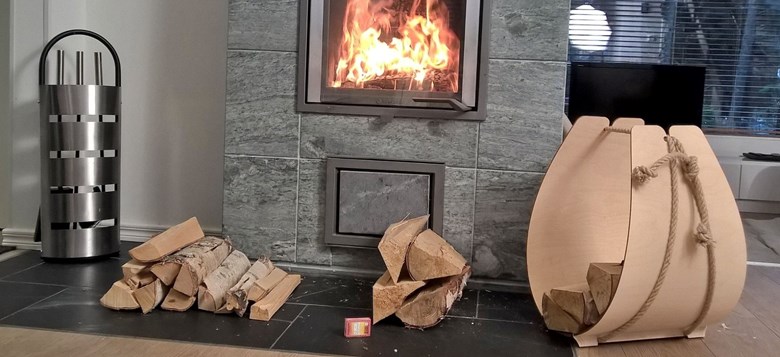Low-emission wood burning

Wood is renewable energy, but wood burning still causes harmful emissions. Everyone can influence how cleanly wood burns. The most important thing is to only burn dry wood – not rubbish or anything else.
The use of fireplaces generates emissions into the air. The emissions are high in poor combustion, i.e. if waste or damp wood is burned. In this case, a lot of particles, carbon monoxide and hydrocarbons are released into the air through the chimney. These are harmful to human health and also reduce comfort. Poor combustion of wood produces black carbon, or soot, which is transported from Finland’s latitudes to the Arctic and advances the melting of ice.
Everyone can influence how cleanly wood burns. It is all based on the quality and dryness of the firewood. Even an old fireplace can be used skilfully, reducing the amount of pollutants formed.
Burning cardboard and paper produces a lot of ash and soot. The resulting energy gains are also negligible. Recyclable material should be recycled for industrial needs.
How to avoid the disadvantages of wood burning:
- Use dry and clean wood.
- Do not burn waste or recyclable material.
- Avoid burning with insufficient air.
- Learn how the weather affects smoke behaviour.
- Do not smoke out your neighbours.
Use your fireplace skilfully
Aim for colourless, low-emission smoke. Follow the instruction manual of your fireplace. If there is none, these guidelines will help you succeed.
-
1
Ensure sufficient draught
Before lighting, you should make sure that the draught is sufficient with a match, for example.
Everything is fine if the smoke from the match goes merrily up the chimney flue. If not, check whether there is enough replacement air entering the room or whether the cooker hood or central vacuum system has been left on. If the draught is still not sufficient, warm up the chimney flue using a hot air blower, for example. You should not light a fire if there is no draught.
Make sure that the fireplace receives enough air for combustion. Open a ventilation window or adjust the mechanical ventilation system.
-
2
Light from the top
As a rule, the best way to light a heat-storing fireplace is lighting it from the top. When lighting a wood-burning stove, it is important to kindle the wood quickly. However, check the instruction manual of your fireplace for how to use your own fireplace correctly. Check out our tips for lighting from the top here.
-
3
Adjust the draught during burning
Keep the chimney damper open. If the draught is too strong, adjust it by reducing the air vents of the fireplace rather than by closing the damper. Also make sure that there is enough replacement air entering the room by opening a window or adjusting the ventilation, for example.
If necessary, add the new load of firewood on top of the embers so that the wood kindles quickly and well. Use larger pieces of wood in the second load than in the first, if possible.
The final embers burn slowly because the gaseous substances have burned out and all that is left is carbon combustion. Burning can be accelerated, for example, by closing the air supply holes in the door and directing as much combustion air through the grate as possible.
When the embers have almost burned out and flames are no longer visible, close the air supply and reduce the opening of the chimney damper. Close the damper completely only when there are no more glowing embers in the firebox. They are still releasing carbon monoxide, which is an invisible toxic gas.
-
4
Do not overheat
Heating the fireplace too hot may, at worst, damage its structures. In a soapstone fireplace, for example, you can burn a maximum of 10 kilograms of wood per one tonne of weight of the fireplace at a time. This amount may be lower for other fireplaces. Burning small loads of firewood should be preferred.
-
5
Do not burn cardboard
Everything that burns is not suitable for burning in a fireplace. Burning rubbish damages the fireplace and produces a lot of smoke and compounds harmful to health.
Burning cardboard and paper produces a lot of ash and soot, which clog the smoke flues. Burning plastic and other waste at the low combustion temperature of a home fireplace produces toxic particles and gases. Wood or chipboard that is wet, painted, impregnated or contains other harmful substances is also not suitable for burning.
Waste management and environmental regulations prohibit the burning of rubbish in fireplaces or on an open fire. All recyclable material should therefore be recycled for industrial needs.
So milk cartons, cardboard and paper belong in recycling, not burning in your fireplace.